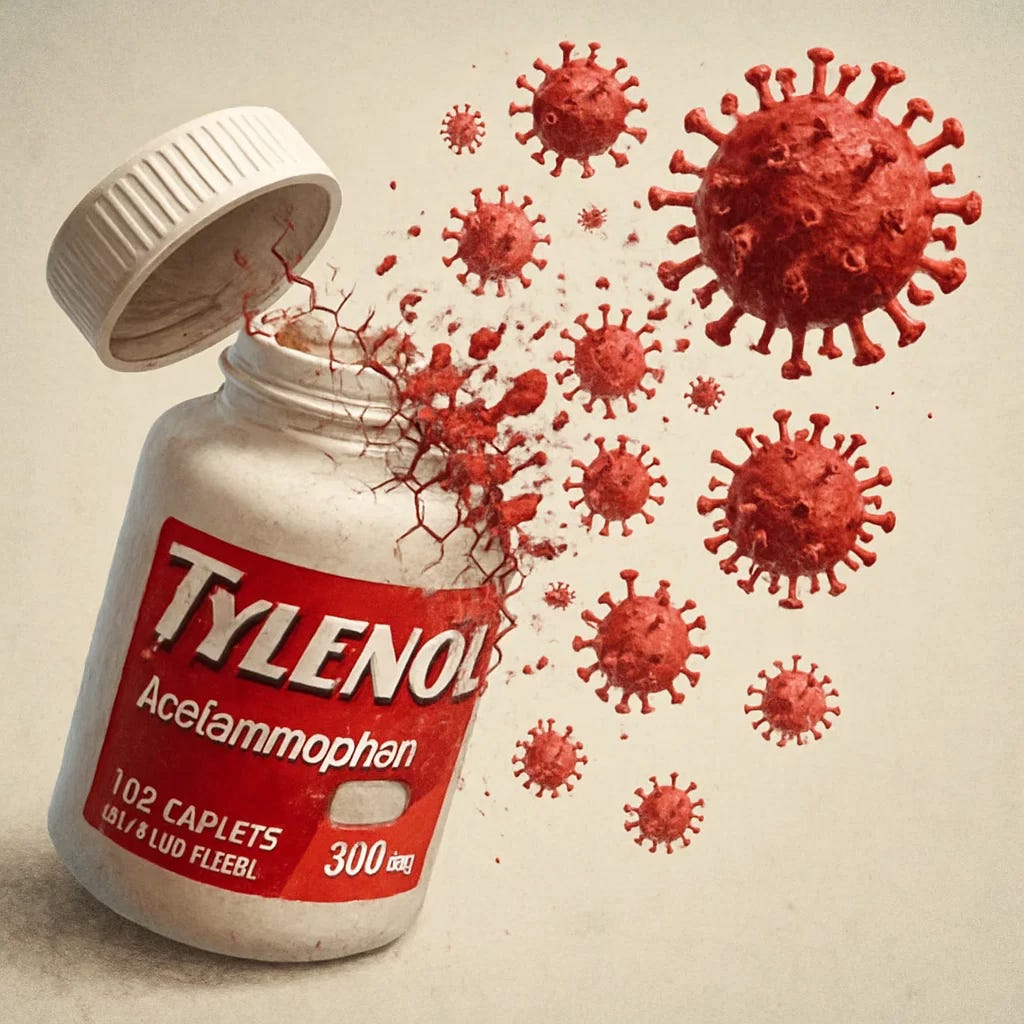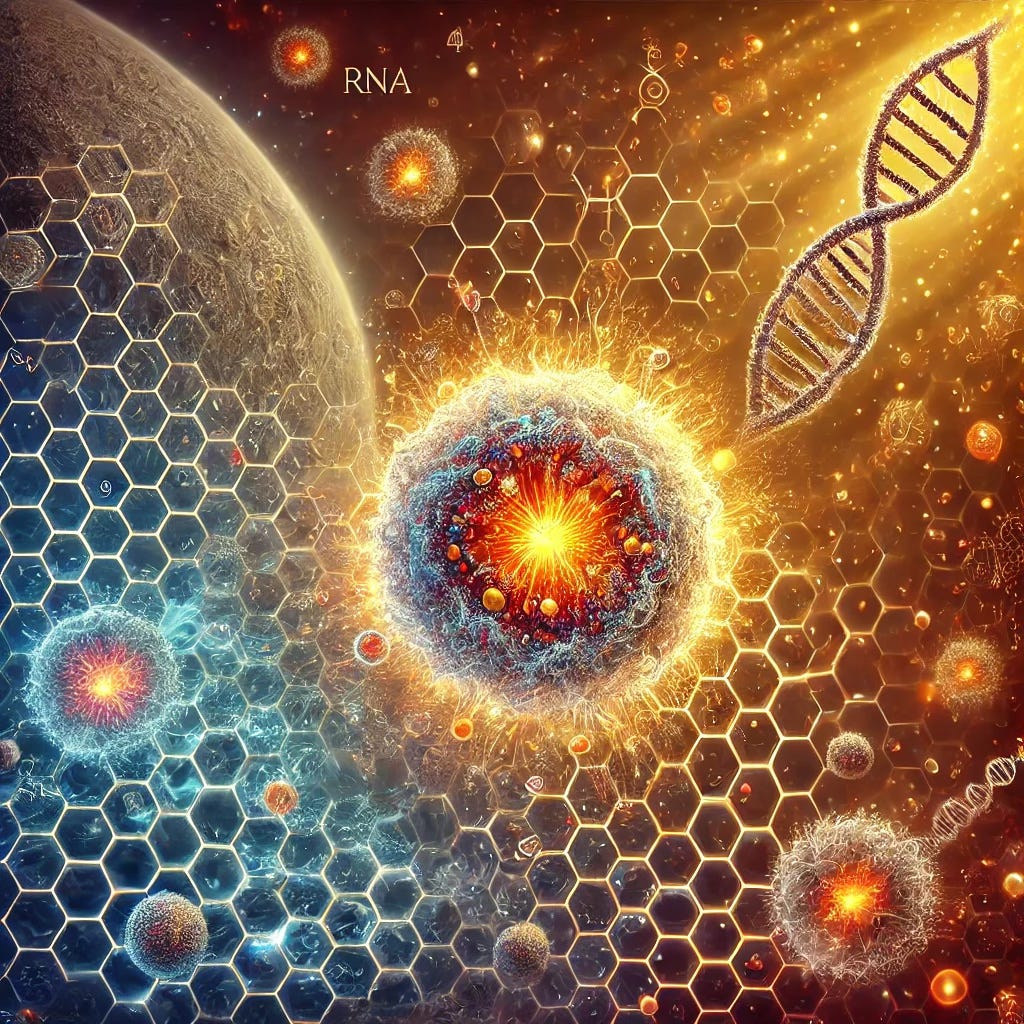Reframing Viral Mechanisms: Exosomes, Toxicity, and the Xenogen Hypothesis
Rethinking Pathogenic Assumptions in the Age of Environmental Stress
In a 2018 study published in Scientific Reports, researchers explored the effects of acetaminophen-induced liver injury in mice, with an initial focus on validating toxicological mechanisms of liver damage. However, their findings inadvertently cast light on a much deeper—and potentially paradigm-shifting—insight into the nature of so-called "viral" disease.
The study demonstrated that mice exposed to a toxic dose of acetaminophen (aka Tylenol) released large numbers of ‘virus like’ exosomes—nano-sized, membrane-bound vesicles—into their bloodstream. These exosomes were then isolated and administered to healthy recipient mice. Astonishingly, the exosomes alone, without any exposure to the original drug, induced significant hepatocellular damage, oxidative stress, inflammatory signaling (TNF-α, IL-1β), and apoptosis in the recipients. Similar ‘pseudo-infectious’ toxic effects were observed in vitro in both primary hepatocytes and hepatoma cell lines.
This study offers direct empirical support for a view I have developed and shared in previous writings and livestreams, namely: what we have long identified as “viruses” may in fact be misidentified endogenous particles—such as exosomes or microvesicles—released from stressed or dying cells. These particles may appear infectious in behavior and morphology, yet their emergence is often a consequence of toxic insult, not an autonomous pathogenic cause.
Contextualizing Recent Research Challenging Viral Causality
A growing body of research supports this reframing. For instance, a review in Journal of Virology outlines how virus-like particles (VLPs) and exosomes can overlap in both structure and function, complicating the task of definitively identifying viral agents under microscopic analysis (Gould et al. 2003). Studies published in Trends in Microbiology discuss how viral particles may act more as biological modulators of cellular signaling and immune responses than as invasive pathogens in a classical sense (Villarreal 2011).
Additionally, a 2021 paper in Cell offers a comprehensive overview of how chronic environmental stressors—including pollutants, non-native EMFs, and dietary toxins—can produce hallmarks of disease at the cellular level through membrane disruption, oxidative damage, and altered intercellular communication (Helmrich et al. 2021). A complementary analysis in BMC Biology documents how such stressors can generate plasma membrane remodeling and cell death pathways independent of viral infection, thus potentially giving rise to cellular debris or vesicles that are mistaken for virions (Katsnelson et al. 2021).
Together, these studies support the assertion that what we often frame as a contagious viral phenomenon may actually be a set of biological responses to environmental disruption, facilitated by the body’s own mechanisms of detoxification, repair, and intercellular communication.
The Xenogen Hypothesis
This reframing aligns with a broader perspective I have termed the Xenogen Hypothesis—a synthesis of systems biology, environmental medicine, and non-reductionist cell theory.
“Xenogen” is a term that merges xeno (“foreign” or “other”) with -gen (“to generate”), offering a linguistic container for the idea that certain biomolecular vectors—whether exosomes, virion-like particles, or other nucleic-acid based carriers—do not cause disease, but rather serve as informational messengers involved in an intelligent biological response to environmental stressors.
In this model, the symptoms commonly associated with infectious illness—fever, fatigue, mucus production, diarrhea, etc.—are not signs of pathological invasion but expressions of detoxification and regenerative signaling. These symptoms are not the result of being overcome by a pathogenic entity, but rather initiated by the organism in response to environmental inputs, including toxicants, dietary incompatibilities, or non-native electromagnetic fields.
From this perspective, virion-like particles are not foreign invaders, but xenohormetic vectors: biologically encoded stress signals that catalyze self-organizing, self-cleansing responses in the body and perhaps even across populations.
Informational Transfer vs. Infection
The Scientific Reports study provides a tangible mechanism for this view. Exosomes released from chemically stressed liver cells contain a complex cargo of RNA, proteins, and oxidative signals. These particles are capable of transferring that information to other cells—provoking in them similar patterns of stress response, inflammation, and in some cases, apoptosis.
Key Mechanistic Findings in the Study
Exosomes released from acetaminophen (APAP)-injured livers carry toxic signals, capable of inducing apoptosis, inflammation, and oxidative stress in healthy recipient liver cells and mice.
These exosomes increase reactive oxygen species (ROS), TNF-α, IL-1β, and activate apoptotic proteins (Bax, cleaved caspase-3/9) through the JNK signaling pathway.
The exosomes were absorbed by recipient hepatocytes, leading to time-dependent cellular damage, which the authors attribute to the exosome cargo—including nucleic acids and proteins associated with toxicity.
This is a clear demonstration that vesicles released from damaged cells can induce "infectious-like" symptoms without any pathogen present—a finding highly supportive of the xenogen thesis.
Reframing Exosomes as "Virus-Like" Particles
Vesicle Emission ≠ Viral Transmission, but Detox Signaling
Exosomes released after toxicant-induced membrane compromise (e.g., NAPQI from APAP metabolism) contain not just miRNA and proteins, but signals of damage and adaptation.
These vesicles are indistinguishable in morphology from viruses (40–150 nm), often contain nucleic acids, and travel between cells—yet are not pathogens.
This aligns with the concept that “viruses” could often be misunderstood detox communicators—not causative agents.
Misattribution of Cause: Vesicles as Effect, Not Primary Agent
Traditional germ theory frames such exosome-like particles as "viruses" causing disease.
But this study clearly shows the particles only exist after APAP-induced toxicity—i.e., they are a secondary effect of a primary toxic exposure, not the initiators of disease.
Environmental Stressors Create Bio-Mimetic “Viral” Behavior
The observed cell-to-cell toxicity, upregulated inflammatory and apoptotic gene expression, and even systemic effects in recipient mice mirror "viral" pathogenicity.
However, the only source was toxicant-induced cellular death, not external infection.
Thus, this is not contagion, but transmission of internal damage memory, and a ‘xenohormetic’ response that may facilitate as of yet unknown benefits to the organism.
The Fourth Phase of Water & Membrane Dynamics
Though not directly addressed in this paper, the reference to the fourth phase of water (EZ water) is key to understanding how the body mobilizes, expels, and communicates toxic stress. Gerald Pollack’s work on EZ water describes a gel-like, structured phase of water that lines hydrophilic surfaces, particularly cell membranes. This structured water is essential for maintaining membrane integrity, charge separation, and cellular energy flow.
In times of toxic overload—whether from pharmaceuticals like acetaminophen, environmental pollutants, or metabolic waste—EZ water collapses into a less structured, more liquid phase. This transition appears to facilitate the excretion of intracellular waste, including oxidized proteins, nucleic acids, and damaged cellular material. These contents are often expelled in the form of microvesicles or exosomes, which may be misidentified as viruses.
Fever, a classic symptom long pathologized in allopathic medicine, is central to this process. Elevated body temperature disrupts the gel-like EZ water, temporarily liquefying it. This allows membranes to become more permeable, easing the release of exosomes, damaged nucleic acids (misidentified via PCR as ‘viruses’ versus cleansed biomolecules) and soluble waste into the extracellular environment, including through sweat. Sweating via fever, far from being merely a symptom, becomes a core detoxification mechanism.
From a broader thermoregulatory view, this mimics ancient environmental cycles. The alternating exposure to heat and cold—once a regular part of diurnal and seasonal rhythms—has largely been replaced by artificially stabilized environments: air conditioning, indoor heating, and sedentary indoor lifestyles. In this context, episodic "cold and flu" responses may function as endogenous simulations of a lost ecological rhythm. Fever and chills may act as a biological form of paleorestoration, reintroducing the temperature fluctuations necessary for optimal cellular hygiene.
Interestingly, modern health practices such as sauna use, cold plunging, and intermittent fasting seem to tap into this same biological intelligence. These rituals mimic natural cycles of thermal and metabolic stress, activating autophagy, vesicle release, and hormonal adaptation.
In this expanded frame, influenza and similar syndromes—especially in the absence of clear pathogenic isolation—can be interpreted not as contagion, but as seasonal cleansing responses. They reflect the body’s effort to maintain coherence with disrupted environmental signals, discharging accumulated toxicity through precisely orchestrated episodes of heat, mucus production, lethargy, and purification.
This reconceptualization not only liberates us from fear-based germ logic but opens the door to re-integrating ancestral knowledge with emerging biophysical science.
Summary of Paradigm Shift Supported by This Study
Conclusion
This paper is an essential piece of evidence for the xenogen hypothesis. It validates the idea that:
Exosomes carry stress signatures from damaged cells;
These particles can induce systemic symptoms in the absence of pathogens;
The dominant ‘viral contagion/germ theory’ framework misinterprets detox signals as causal agents—effect is mistaken for cause.
These findings urge us to re-examine what we mean by "virus" and to distinguish between correlated biological markers and actual causal agents of disease. Just as symptoms are not the disease itself, the presence of a particle does not necessitate pathogenicity. The Tylenol-exosome study affirms this: what appears pathogenic may in fact be a reflection of the body’s attempt to repair, cleanse, or communicate.
In future essays, I will expand this discussion to include the possible roles of psychogenicity in the "spread" of illness—as suggested by the work of Luc Montagnier and others—and the implications for public health, environmental justice, and the spiritual integrity of medicine.
For now, let this stand as a call to inquiry: to move beyond fear-based models of contagion, and toward a biology of coherence, resilience, and truth.
Interested in learning more? Read Part 2: Poisoned Not Infected: Reinterpreting Viral Disease through Chemical Toxicity
References
Gould, S. J., Booth, A. M., & Hildreth, J. E. K. (2003). The Trojan exosome hypothesis. Proceedings of the National Academy of Sciences, 100(19), 10592–10597.
Villarreal, L. P. (2011). Viral ancestors of antiviral systems. Nature Reviews Microbiology, 9(9), 722–732.
Afsaneh Javdani-Mallak, Iman Salahshoori, Environmental pollutants and exosomes: A new paradigm in environmental health and disease, Science of The Total Environment, Volume 925, 2024,
Ammendolia, D.A., Bement, W.M. & Brumell, J.H. Plasma membrane integrity: implications for health and disease. BMC Biol 19, 71 (2021). https://doi.org/10.1186/s12915-021-00972-y







Wow, this is mind blowing! You debunk the contagion theory of viral disease, and explain how we’re being made sick by a wide variety of substances we eat, inject, and are otherwise exposed to. I’ve been researching nanotech in food this week, and I can’t help seeing the similarities between the damage done by nano food ingredients and that done by the nano lipid particle bioweapons delivery system. I remain fascinated by the fact that Avril Haines’s father Thomas figured out how to use squalene as a “natural” lipid nano delivery system that was used for the anthrax vaccines and he invented the first lipid nano delivered drug Doxil (chemo), which has very similar “side effects” to the COVID shots, especially when those present as skin lesions. Certainly, injecting mRNA instructions to produce the COVID spike protein is a nasty bioweapon, but the delivery system itself may be equally deadly. We’re being inundated with nanoparticles from drugs and vaccines, food, cosmetics and personal care products, and even from the skies via geoengineering. Before COVID I didn’t see these things as a connected conspiracy, but I can’t discount that now. I haven’t researched EMF myself, but I’m sure if I did I would understand how that fits in, too. Here’s one theory, with a lot of published scientific evidence to back it up: https://open.substack.com/pub/stylman/p/node-without-consent Depopulation and control.
Brilliant. We finally have an explanation in detail of the actual process. I've said this for years, but now we can explain it better. Thank you so much.